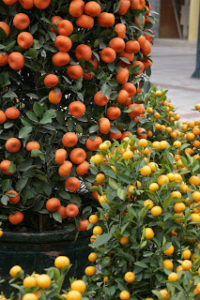
Photo Courtesy of Andy Jien.
In a previous blog post, we talked about two of the few fall fruiting trees, Persimmons and Pomegranates. Today’s blog will be about citrus trees, some of the few winter fruiting trees. Citrus is a commonly used term that refers to several of the flowering varieties of the genus Citrus; the fruiting trees included within this genus are: lemons, limes, oranges, grapefruit, tangerines, and most species of kumquats.
Citrus trees come in many different sizes and colors. There are standard varieties which grow to be approximately15-25 ft. in height, semi-dwarves are roughly between 8-15 ft. tall, and dwarves (which are the variety at most of the IEUA’s school gardens) are about 4-8 ft. tall. Citrus trees begin to flower in the fall and by December most of their fruit have developed. They need a diurnal winter to change color, so our Mediterrenean climate is perfect for witnessing some of the beautiful colors of some citrus species. Some citrus trees grown in tropical locations never experience cool temperatures, which makes them stay green year round even when ripe.
If you live in an area that is near the Inland Empire Utilities Agency (Chino, Montclair, Ontario, Upland, Rancho Cucamonga), then it is likely that citrus trees have played a role in your city’s history. As a fun project, have your students research the role that citrus played in your city. Try to find out which species of citrus were grown in your area and by whom.
For more reading on citrus and its role in Inland Empire history, please see the following websites:
http://en.wikipedia.org/wiki/Citrus Time line of Citrus in the Inland Empire:
